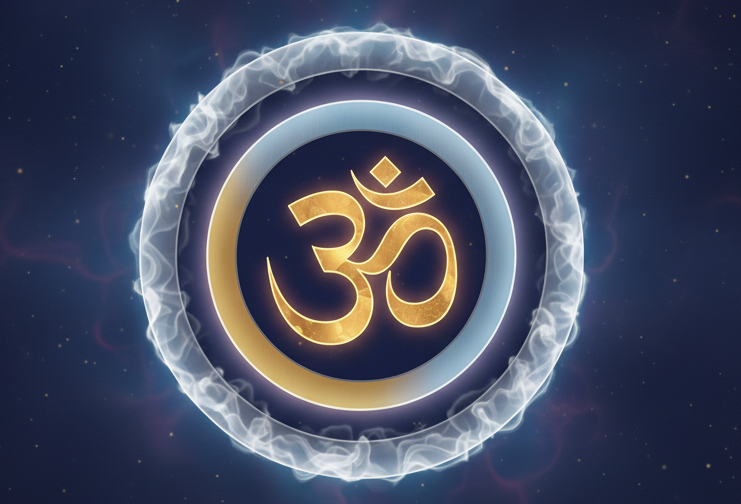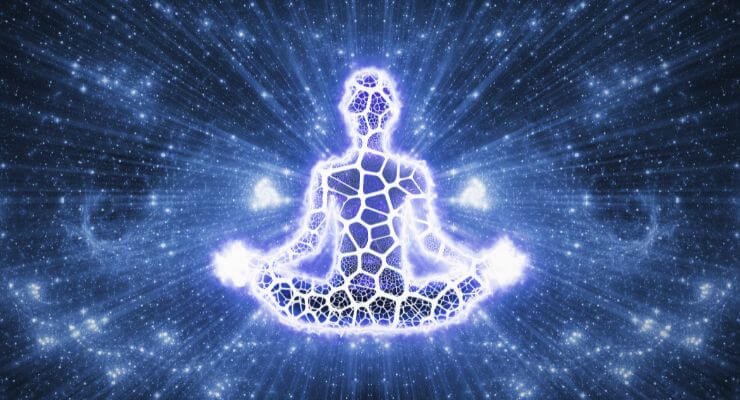The Māṇḍūkya Upaniṣad may be the shortest of all the Upaniṣads, with only twelve verses, but its depth is astonishing. In this compact text lies the essence of the Vedas, the power of Om, and a complete map of human consciousness. It takes us beyond waking and dreaming into the silence of pure awareness, pointing to liberation itself. For yoga practitioners, seekers of meditation, and students of Vedanta, this Upaniṣad is a timeless guide.
Why the Māṇḍūkya Upaniṣad Still Matters
At its core, the Upaniṣads are not abstract philosophy; they are manuals for the inner journey. The Māṇḍūkya Upaniṣad, belonging to the Atharva Veda, presents a radical truth in simple words: Ayam Ātmā Brahma, meaning “This Self is Brahman.” In other words, the same Self that shines within us is none other than the cosmic reality that sustains everything. Unlike other longer Upaniṣads, this one wastes no words. It introduces Om (Aum) as the key to understanding the Self and the universe, and then directly explains how Om relates to the four states of consciousness that we all experience.
Om: More Than a Sound
Most of us know Om as a chant that begins and ends meditation or yoga sessions. But the Māṇḍūkya Upaniṣad reveals that Om is far more than a sound; it is the very expression of existence. The text opens with the declaration that “Om is all this past, present, and future. Whatever lies beyond time is also Om.” When chanted with awareness, Om is not just a vibration in the air; it is the sound-symbol of consciousness itself.
Om has four parts: A, U, M, and the silence that follows. Each part corresponds to one of the four states of human experience: waking, dreaming, deep sleep, and Turīya, the transcendental awareness that underlies all states.
The structure of Om
- A (अ) maps to the waking state (outer awareness).
- U (उ) maps to the dream state (inner/subtle awareness).
- M (म्) maps to deep sleep (undifferentiated peace/bliss).
- Silence after A-U-M points to Turīya — the unconditioned, non-dual Self.
The Four States of Consciousness
The brilliance of the Māṇḍūkya Upaniṣad lies in its ability to take something we all know, the daily cycle of waking, dreaming, and sleeping, and demonstrate how these experiences serve as doorways into the infinite Self.
Waking: Jāgrat (Vaiśvānara)
The waking state is outward-facing, where we engage the senses, act in the world, and experience physical reality. It corresponds to the sound A in Om, the beginning of all articulation.
Dreaming: Svapna (Taijasa)
The dreaming state turns awareness inward. Here the mind plays with impressions, memories, and subtle experiences. This state corresponds to U, which bridges A and M, just as dreams bridge waking and deep sleep.
Deep Sleep: Suṣupti (Prājña)
In deep, dreamless sleep, desires fall silent and there is no duality. This state is full of peace, yet unconscious. It corresponds to M, where sound closes into silence, suggesting rest and dissolution.
Turīya: The Fourth
Beyond all three is Turīya, the silent witness of every state. It is not waking, not dreaming, not sleeping, but pure consciousness itself peaceful, auspicious, and non-dual. In Om, Turīya is represented not by sound, but by the silence after A-U-M. It is the ever-present ground of awareness, to be realized through meditation.
A Practical Path for Seekers
The Māṇḍūkya is not just theory; it is practice-friendly. One of the simplest ways to explore its wisdom is through Om meditation. Sit quietly, chant A-U-M slowly, and rest in the silence that follows. Notice how each part of Om reflects a different quality of awareness: the outward focus of waking, the subtle play of dreaming, the rest of deep sleep, and the silence of Turīya. Over time, this practice reveals that behind all experiences, there is one unchanging Self.
Alongside chanting, self-inquiry deepens the experience. Ask yourself: Who is aware of waking, dreaming, and sleeping? What remains unchanged while states come and go? These questions lead attention to the Self, which is always present but often unnoticed.
The 12 Mantras of the Māṇḍūkya Upaniṣad
To appreciate the depth of this text, here are the twelve mantras in Sanskrit, with transliteration and English translation.
Mantra 1
Sanskrit
ॐ इत्येतदक्षरमिदं सर्वम् । तस्योपव्याख्यानं भूतं भवद्भविष्यदिति सर्वम ॐकार एव । यच्चान्यत् त्रिकालातीतं तदप्योऽङ्कार एव ॥
Transliteration
oṃ ity etad akṣaram idaṃ sarvam | tasyopavyākhyānam bhūtaṃ bhavat bhaviṣyad iti sarvam oṅkāra eva | yac cānyat trikālātītaṃ tad apy oṅkāra eva ||
Translation
Om — this imperishable syllable — is everything. Its explanation: all that was, all that is, and all that will be are Om. Whatever is beyond the three times (past, present, future) is also Om.
Mantra 2
Sanskrit
सर्वं ह्येतद् ब्रह्मायमात्मा ब्रह्म सोऽयमात्मा चतुष्पात् ॥
Transliteration
sarvaṃ hi etad brahmāyam ātmā brahma so ’yam ātmā catuṣpāt ||
Translation
All this indeed is Brahman; this Self is Brahman. This Self has four quarters (four aspects or states).
Mantra 3
Sanskrit
जागरितस्थानो बहिष्प्रज्ञः सप्ताङ्ग एकोनविंशतिमुखः स्थूलभुगेवैश्वानरः प्रथमः पादः ॥
Transliteration
jāgaritasthāno bahiṣprajñaḥ saptāṅga ekonaviṃśatimukhaḥ sthūlabhuke vaiśvānaraḥ prathamaḥ pādaḥ ||
Translation
The waking state (jāgrat) is outwardly cognitive (bahiṣprajña); it has seven limbs and nineteen mouths and experiences gross objects — this is Vaiśvānara, the first quarter.
Mantra 4
Sanskrit
स्वप्नस्थानोऽन्तःप्रज्ञः सप्ताङ्ग एकोनविंशतिमुखः प्रविविक्तभुगे तैजसोऽयमध्यमः पादः ॥
Transliteration
svapnasthāno antaḥprajñaḥ saptāṅga ekonaviṃśatimukhaḥ praviviktabhuke taijasaḥ dvitīyaḥ pādaḥ ||
Translation
The dream state (svapna) is inwardly cognitive (antaḥprajña); it also has seven limbs and nineteen mouths and experiences subtle objects — this is Taijasa, the second quarter.
Mantra 5
Sanskrit
यत्र सुप्तो न कञ्चन कामं कामयते न कञ्चन स्वप्नं पश्यति तत् सुषुप्तम् । सुषुप्तस्थान एकीभूतः प्रज्ञानघन एवानन्दमयोऽनन्दभुक् चेतोमुखः प्राज्ञस्तृतीयः पादः ॥
Transliteration
yatra supto na kañcana kāmaṃ kāmayate na kañcana svapnaṃ paśyati tat suṣuptam | suṣuptasthāna ekībhūtaḥ prajñānaghana evānandamayo hy ānandabhuk chetomukhaḥ prājñaḥ tṛtīyaḥ pādaḥ ||
Translation
That in which (when asleep) one desires no desire and sees no dream — that is deep sleep (suṣupti). The deep-sleep state, unified and a mass of consciousness, is full of bliss and enjoys bliss; its doorway is the mind. This is Prājña, the third quarter.
Mantra 6
Sanskrit
एष सर्वेश्वरः एष सर्वज्ञः एषोऽन्तर्याम्येष योनिः सर्वस्य प्रभवाप्ययौ हि भूतानाम् ॥
Transliteration
eṣa sarveśvaraḥ eṣa sarvajñaḥ eṣo ’ntaryāmy eṣa yoniḥ sarvasya prabhavāpyayau hi bhūtānām ||
Translation
This Self is the Lord of all, the knower of all, the inner controller. This is the source and dissolution of all beings.
Mantra 7
Sanskrit
नान्तःप्रज्ञं न बहिष्प्रज्ञं नोभयतःप्रज्ञं न प्रज्ञानघनं न प्रज्ञं नाप्रज्ञम् । अदृष्टमव्यवहार्यमग्राह्यमलक्षणं अचिन्त्यमव्यपदेश्यमेकात्मप्रत्ययसारं प्रपञ्चोपशमं शान्तं शिवं अद्वैतं चतुर्थं मन्यन्ते स आत्मा स विज्ञेयः ॥
Transliteration
nāntaḥprajñaṃ na bahiṣprajñaṃ nobhayataḥprajñaṃ na prajñānaghanaṃ na prajñaṃ nāprajñam | adṛṣṭam avyavahāryam agrāhyam alakṣaṇaṃ acintyam avyapadeśyam ekātmapratyayasāraṃ prapañcopaśamaṃ śāntaṃ śivaṃ advaitaṃ caturthaṃ manyante sa ātmā sa vijñeyaḥ ||
Translation
The fourth (Turīya) is not inwardly cognitive, not outwardly cognitive, not both, not a mass of consciousness, not merely conscious, nor unconscious. It is unseen, beyond transactional activity, not graspable, without distinctive marks, not thinkable, not expressible; it is the essence of the One-Self’s awareness, the cessation of all multiplicity, quiet, auspicious, non-dual. This is the fourth; that Self should be known.
Mantra 8
Sanskrit
सोऽयमात्माध्यक्षरमोङ्कारोऽधिमात्रं पादमात्रा मात्रा च पादा अकारा उकार मकार इति ॥
Transliteration
so ’yam ātmādhyakṣaraḥ oṅkāro ’dhimātraṃ pādamātrā mātrā ca pādā akāra ukāra makāra iti ||
Translation
This Self is the imperishable syllable: Om. The parts of Om are the measures of the quarters: the letter A is the first measure (waking), U the second (dream), M the third (deep sleep).
Mantra 9
Sanskrit
जागरितस्थानो वैश्वानरः आकारः प्रथमः मात्रा । आप्तेरादिमत्वाद्वा आप्नोति ह वै सर्वान्कामानादिश्च भवति य एवं वेद ॥
Transliteration
jāgaritasthāno vaiśvānaraḥ ākāraḥ prathamā mātrā | āptero ’dimatvād vā āpnoti ha vai sarvān kāmān ādiś ca bhavati ya evaṃ veda ||
Translation
The waking state (Vaiśvānara) corresponds to A (ākāra), the first measure. He who knows this obtains all desires and becomes foremost.
Mantra 10
Sanskrit
स्वप्नस्थानस्तैजस उकारो द्वितीया मात्रा । ऊर्ध्वत्वादुत्कर्षात् वा ऊणत्वाद्वा ह वै ज्ञानसन्ततिं समुत्कर्षति समानश्च भवति नास्य ब्रह्मवित्कुले भवति य एवं वेद ॥
Transliteration
svapnasthānas taijasa ukāraḥ dvitīyā mātrā | ūrdhvatvād utkarṣāt vā ūṇatvād vā ha vai jñānasantatiṃ samutkarṣati samānaś ca bhavati nāsya brahmavit kule bhavati ya evaṃ veda ||
Translation
The dream-state (Taijasa) corresponds to U (ukāra), the second measure. He who knows this raises the stream of knowledge; he becomes balanced and is not born into an ignorant lineage.
Mantra 11
Sanskrit
सुषुप्तस्थानः प्राज्ञो मकारस्तृतीया मात्रा । मिति सम्पत्तेरापीत्याद्भावात् वा मिनोति ह वा इदं सर्वम् आपीतिश्च भवति य एवं वेद ॥
Transliteration
suṣuptasthānaḥ prājño makāraḥ tṛtīyā mātrā | miti sampatter āpītyād bhāvāt vā minoti ha vā idaṃ sarvam āpītiś ca bhavati ya evaṃ veda ||
Translation
The deep-sleep state (Prājña) corresponds to M (makāra), the third measure. He who knows this measures, attains fullness, becomes the support of all.
Mantra 12
Sanskrit
अमात्रश्चतुर्थोऽव्यवहार्यः प्रपञ्चोपशमः शिवोऽद्वैत एवम ॐकार आत्मैव । स आत्मा स्वयं ज्ञेयः ॥
Transliteration
amātraścaturtho ’vyavahāryaḥ prapañcopaśamaḥ śivo ’dvaitaḥ evam oṅkāra ātmāiva | sa ātmā svayaṃ jñeyaḥ ||
Translation
The fourth (Turīya) has no measure, is beyond activity, the cessation of all phenomena, auspicious, non-dual. Thus Om is the Self itself. That Self is to be known directly.
Living the Wisdom of the Māṇḍūkya
The Māṇḍūkya Upaniṣad is not only for philosophers or monks. Its insight is practical: it tells us that our true nature is not confined to waking, dreaming, or sleep, but is the silent awareness in which all these states appear. In today’s fast-paced, noisy world, the practice of Om meditation offers a way back to inner stillness. Chanting Om, resting in its silence, and reflecting on its meaning can shift daily life into a practice of awareness.
At Nada Yoga School in Rishikesh, this teaching comes alive through sound, meditation, and self-inquiry. Whether you are drawn to Nada Yoga teacher training or retreats, the wisdom of the Māṇḍūkya shows that every sound, every silence, and every state of mind is a doorway to the Self.





